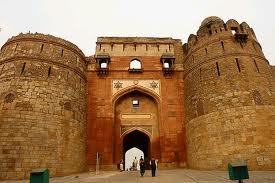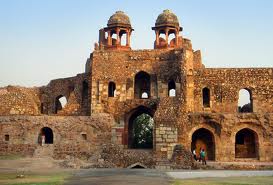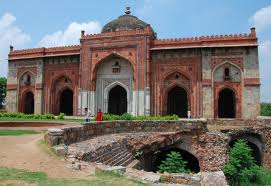Purana Qila
Book Now
Purana Qila in Delhi
 When the second Mughal emperor Humayun decided to make a city of his own he decided on the site of the ancient city of Indraprastha. Humayun was quite a scholar with a fine grasp on such matters and so it is certain that the site was chosen deliberately. When his enemy Sher Shah Suri overthrew him, he destroyed most of Dinpanah (refuge of the faithful) as the city of Humayun was called to make way for his own Dilli Sher Shahi or Shergarh. Incidentally, Humayun was probably the only emperor in history who built a city in Delhi and did not give it his own name – this was typical of Humayun's rather sophisticated and dreamy character. When the second Mughal emperor Humayun decided to make a city of his own he decided on the site of the ancient city of Indraprastha. Humayun was quite a scholar with a fine grasp on such matters and so it is certain that the site was chosen deliberately. When his enemy Sher Shah Suri overthrew him, he destroyed most of Dinpanah (refuge of the faithful) as the city of Humayun was called to make way for his own Dilli Sher Shahi or Shergarh. Incidentally, Humayun was probably the only emperor in history who built a city in Delhi and did not give it his own name – this was typical of Humayun's rather sophisticated and dreamy character.
History of Purana Qila
Sher Shah Suri and his successor could not complete the city, and when Humayun defeated Sher Shah's son to take back his city, he did not deal with Dilli Sher shahi as the latter had done with Dinpanah. In fact the Mughal emperor very handsomely completed the city and even used several of the buildings like the Sher Mandal, a rather pretty two-storeyed octagonal building. Humayun used this as his library and, then tripped to his death from its steps.
Purana Qila - Excavation of Grey Ware Pottery
Several excavations have taken place in the Purana Qila in an attempt to prove, or disprove as the case may  be, whether it is indeed the site of Indraprastha or not. Diggings have yielded Painted Grey Ware pottery which has been dated to 1000BC. Similar stuff has been noticed in other sites associated with the epic Mahabharata as well, which seem to conclusively prove that this indeed was the place where Indraprastha once flourished. These excavation have also thrown up material, like coins, associated with the Gupta (about 4-5th century AD) and post-Gupta ages (700-800AD) of Indian history as well. be, whether it is indeed the site of Indraprastha or not. Diggings have yielded Painted Grey Ware pottery which has been dated to 1000BC. Similar stuff has been noticed in other sites associated with the epic Mahabharata as well, which seem to conclusively prove that this indeed was the place where Indraprastha once flourished. These excavation have also thrown up material, like coins, associated with the Gupta (about 4-5th century AD) and post-Gupta ages (700-800AD) of Indian history as well.
Qila-i-kuhna Masjid
One of the most fascinating buildings, and also one of the few that still survive, in the Purana Qila is the Qila-i -kuhna masjid. Sher Shah Suri built it in 1541 (also see History) and he was obviously out to make a definite style statement. The mosque is quite a place; its prayer hall measures 51.20m by 14.90m and has five doorways with the 'true' horseshoe-shaped arches. Apparently the idea was the build the whole mosque in marble, but the supply ran out and red sandstone had to be used instead. But the builder used the material at hand very skillfully and the result is quite spectacular – the red sandstone and the marble contrast beautifully with each other to give the mosque a very distinctive air. The mihrabs (prayer niches) inside the mosque are richly decorated with concentric arches. From the prayer hall, staircases lead you to the second storey where a narrow passage runs along the rectangular hall. The central alcove is topped by a beautifully worked dome. In the courtyard at one time there was a shallow tank, which had a fountain. The mosque has an inscription which says 'As long as there are people on this earth, may this edifice be frequented, and people be happy in it.' A noble thought – amen to it. -kuhna masjid. Sher Shah Suri built it in 1541 (also see History) and he was obviously out to make a definite style statement. The mosque is quite a place; its prayer hall measures 51.20m by 14.90m and has five doorways with the 'true' horseshoe-shaped arches. Apparently the idea was the build the whole mosque in marble, but the supply ran out and red sandstone had to be used instead. But the builder used the material at hand very skillfully and the result is quite spectacular – the red sandstone and the marble contrast beautifully with each other to give the mosque a very distinctive air. The mihrabs (prayer niches) inside the mosque are richly decorated with concentric arches. From the prayer hall, staircases lead you to the second storey where a narrow passage runs along the rectangular hall. The central alcove is topped by a beautifully worked dome. In the courtyard at one time there was a shallow tank, which had a fountain. The mosque has an inscription which says 'As long as there are people on this earth, may this edifice be frequented, and people be happy in it.' A noble thought – amen to it.
Architecture of Purana Qila
In plan the Old fort, now simply called Purana Qila by Delhites, is irregularly orbital. The walls of the immense Qila tower down on the road that takes one to Pragati Maidan from the height of 18m, and run on for about 2km. It has three main gates – the Humayun darwaza, Talaqi darwaza and Bara darwaza (which one uses to enter the fort today). The double-storeyed gates are quite huge and are built with red sandstone. of all the gates entry was forbidden from Talaqi (forbidden) darwaza, the northern gate. It is not clear why this was so. Other Attractions of The Fort.
More Info
Best time to visit: The best time to visit Delhi is between October and March, when the weather is very pleasant. Most cultural events take place in winter and Delhi is socially very active. By February the flowers are in bloom and the city is really quite pretty then. Summers are searing hot and dry, so do come prepared for the weather.
Trivia: It is believed that Sher Shah could not complete the construction of the Old Fort and it was finished by Humayun. Thus, the well known gate of the fort which is the southern gate is known as Humayun Darwaza.
Timing: You can visit the Old Fort all year round but be sure of the opening and the closing time. The Fort is open on all days of the week from 8:00am to 6:00 pm. The entry fee of Rs 5 for Indian nationals and Rs 100 for foreigners is charged to enter the Purana Qila Fort.
Entry Fees: Indian Rs. 5, Foreigner $2
|